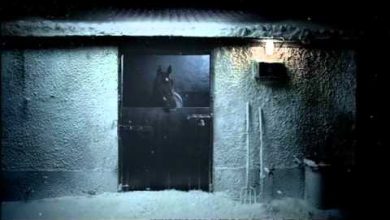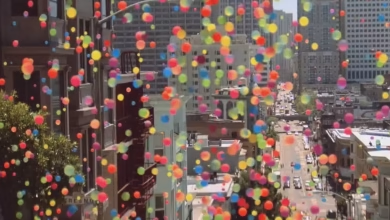Dominic Goldman of You’re the Goods picks his Desert Island Ads
The Ads That Entertained Us
Advertising has always mirrored culture, but at its best it doesn’t just reflect the world, it changes it. The ads that stay with us are the ones that reset how we see ourselves, what we wear, what we listen to. To show that power, I’ve chosen one ad from each of the past five decades. Each mattered in its moment. Each shaped culture in its own way. There is still brilliance out there, but it is scarcer than it was. Forty years ago the ambition was everywhere. Now it’s smothered by algorithms and an obsession with performance over brand.
Desert Island Ads
1980s Levi’s Launderette (1985)
Levi’s Launderette wasn’t just an ad, it was a cultural earthquake. Overnight it changed what we wore, how we styled ourselves, even what we listened to. Growing up in south west London my mates and I went from pastel Tacchini tracksuits, Diadora sneakers and wet look perms (just at the back of our heads of course), to scouring charity shops for vintage 501s, white T shirts and industrial boots. Nick Kamen stripping down to his boxers to the sound of Marvin Gaye flipped our world. From rap music to Motown, from nylon to denim, we followed where the ad led. That was the power of advertising. It didn’t just sell a product, it rewired youth culture. Watching it happen in front of me made me realise I wanted to be part of this world. And it is not lost on me that twenty years later I would end up working for the man who wrote it. For me, Laundrette wasn’t simply about jeans, it was about belonging, aspiration and cool.
1990s Tango St George (1996)
If the eighties showed us advertising could change culture, the nineties proved it could be entertainment in its own right, in a Britain fuelled by Britpop swagger, warehouse raves and nosebleed Drum n Bass. Tango’s St George was ninety seconds of sheer spectacle.
Sebastian probably needed a lie down after Gardner was finished, and so did the regulators fielding the calls. Polarisation isn’t failure, it’s proof people are paying attention. And trying to please everyone is the riskiest thing of all. This was youth culture at full volume.
You didn’t just watch St George, you performed it in the pub. You laughed at the madness of a soft drink brand taking on the French with a marching band and the RAF. Awards followed, but what mattered most was the entertainment. It proved advertising didn’t need to beg for attention. It could seize it, own it, and become the show.
2000s Cadbury Gorilla (2007)
The 2000s had plenty of clever ads. Lynx, Getting Dressed. Got Milk, Birthday. Super smart, well crafted and highly awarded. And then along came Gorilla.
What made Gorilla brilliant was that it wasn’t asking you to think, it was making you feel. Gorilla was a completely different way to deliver what Cadbury stood for. It didn’t explain joy, it made you experience it. YouTube was still in its infancy and suddenly a bar of chocolate had the biggest viral hit on the planet.
The genius was in the nerve. No product spiel, no rational claim, just pure feeling in a furry suit. It picked up the Cannes Film Grand Prix, but the bigger prize was cultural. For once, advertising didn’t need to apologise for being there. It was the headline act.
2010s Nike Write the Future (2010)
Most football ads were predictable. A slow motion volley, a bit of mud on the boots, a tired line about destiny. Then Nike dropped Write the Future and the rest of advertising looked like a bunch of Sunday league fat dads struggling through a hangover.
It was football, politics, celebrity and chaos all colliding in three minutes of cinema.
This was the blockbuster before the World Cup kicked off. Premiered during the Champions League Final, it dominated conversation heading into South Africa 2010. Social media was just beginning to take hold and the film became the first global football ad people actually shared and debated online. By the time the tournament began, the ad had already become part of it.
The brilliance was in how big it dared to be. It wasn’t selling boots or kits. It was showing football as the global drama it really is, life and death played out in ninety minutes. Write the Future proved advertising could match the sport itself for scale and spectacle. For once, the ad was as big as the game.
2020s Liquid Death Iced Tea: Your Grandma’s Energy Drink (2021)
By the time the 2020s arrived, ads had lost their swagger and settled into the colour palette of porridge. Safe templates, algorithm-friendly wallpaper, brands whispering about purpose. Then along came Liquid Death and kicked everyone in the face.
Your Grandma’s Energy Drink was the perfect example. Grannies shotgunning iced tea like teenagers, smashin’ kitchens, raising hell. It was stupid, it was funny, and it was completely unforgettable. Liquid Death is just water. The dullest product on the planet, suddenly the most entertaining brand in the aisle.
That’s the power of brand. By 2024 Liquid Death had pulled in $333 million in revenue, was valued at $1.4 billion, and stacked on shelves in over 133,000 stores worldwide. All from taking the most boring liquid in history and treating it like a death metal band on meth.
While the rest of the category was still talking about purity and mountain springs, Liquid Death was selling rebellion. It proved that when you commit to entertainment, even water can become culture.
Conclusion
The eighties and nineties were a different era. Advertising didn’t just reflect culture, it set it. Brands wanted to shape life, not lurk on the sidelines.
In the last decade that ambition has bled away. Too much of the work is boring. Built for algorithms, not people.
And yet every so often something cuts through. Pure brand. Pure theatre. A reminder that even the dullest product on the shelf can become a movement if you have the guts to back an idea.
When advertising remembers its job is to entertain, it still has the power to stop the world. Without that ambition, it’s game over. The machines will drown us in digital gruel until nobody remembers what magic ever tasted like.
 Dominic Goldman is the founder of You’re the Goods. He is a former managing partner and ECD at BBH.
Dominic Goldman is the founder of You’re the Goods. He is a former managing partner and ECD at BBH.










